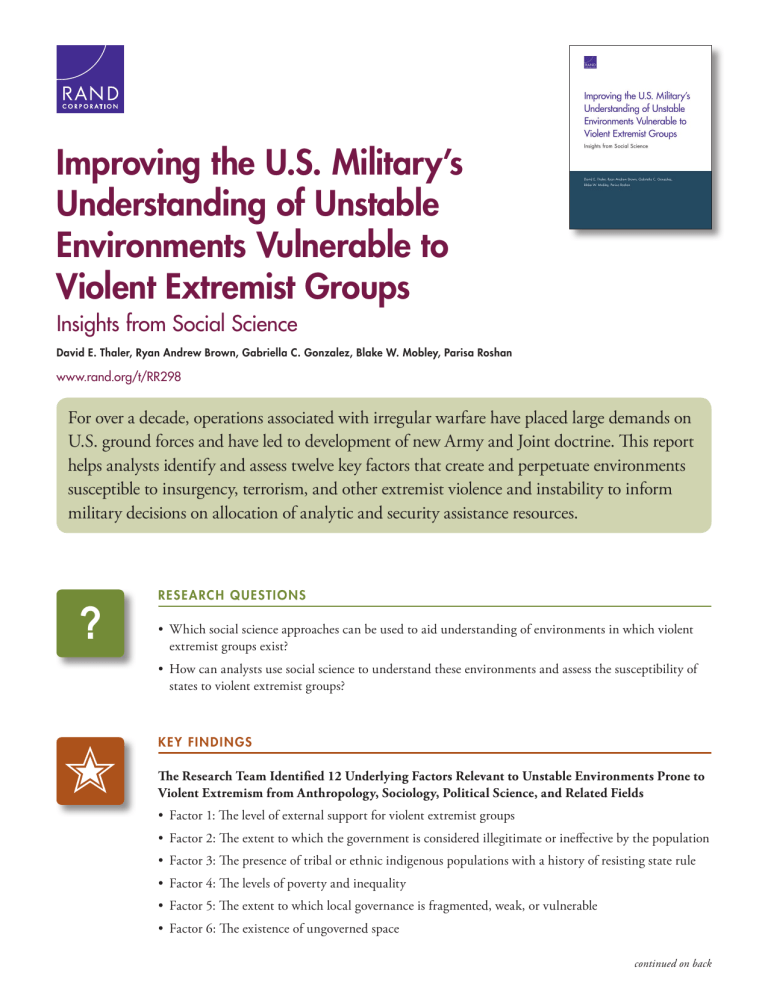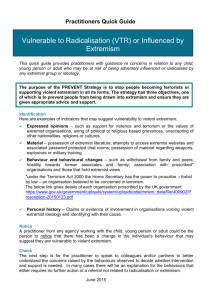Improving the U.S. Military’s Understanding of Unstable Environments Vulnerable to Violent Extremist Groups

C O R P O R A T I O N
Improving the U.S. Military’s
Understanding of Unstable
Environments Vulnerable to
Violent Extremist Groups
Insights from Social Science
David E. Thaler, Ryan Andrew Brown, Gabriella C. Gonzalez, Blake W. Mobley, Parisa Roshan www.rand.org/t/RR298
For over a decade, operations associated with irregular warfare have placed large demands on
U.S. ground forces and have led to development of new Army and Joint doctrine. This report helps analysts identify and assess twelve key factors that create and perpetuate environments susceptible to insurgency, terrorism, and other extremist violence and instability to inform military decisions on allocation of analytic and security assistance resources.
?
✭
RESEARCh QUESTIonS
• Which social science approaches can be used to aid understanding of environments in which violent extremist groups exist?
• How can analysts use social science to understand these environments and assess the susceptibility of states to violent extremist groups?
KEy FInDInGS
The Research Team Identified 12 Underlying Factors Relevant to Unstable Environments Prone to
Violent Extremism from Anthropology, Sociology, Political Science, and Related Fields
• Factor 1: The level of external support for violent extremist groups
• Factor 2: The extent to which the government is considered illegitimate or ineffective by the population
• Factor 3: The presence of tribal or ethnic indigenous populations with a history of resisting state rule
• Factor 4: The levels of poverty and inequality
• Factor 5: The extent to which local governance is fragmented, weak, or vulnerable
• Factor 6: The existence of ungoverned space continued on back
To Do
• Factor 7: The presence of multiple violent, nonstate groups competing for power
• Factor 8: The level of government restriction on political or ideological dissent
• Factor 9: The level of consistency and/or agreement between a violent extremist group’s goals and the ideology of target populations
• Factor 10: The extent to which population and extremist groups perceive faltering government commitment to a counterinsurgency campaign
• Factor 11: The capacity, resources, and expertise of violent extremist groups
• Factor 12: The pervasiveness of social networks
The Factors Can Be Assessed and Tracked Via Metrics
• The factors are linked through complex, mutually dependent interrelationships.
• Qualitative and quantitative metrics can be developed that enable assessment and tracking of factors.
A number of relevant metrics in the public domain are updated annually and can be easily accessed for analysis.
• Metrics can be used to assess and prioritize countries and regions based on the presence of factors that could give rise to unstable environments.
RECoMMEnDATIonS
• Incorporate factors and associated metrics into irregular warfare–related analytic games and models.
• Evaluate levels of potential instability and extremist violence using the assessment scheme outlined in this report.
• Conduct research to probe and map overlays and interrelationships among factors in specific cases.
• Develop a prioritization approach based on the factors and assessment scheme that helps indicate where best to allocate analytic and security-assistance resources.
ARROYO CENTER
RAND Arroyo Center is the Army’s federally funded research and development center for studies and analyses. Its mission is to help Army leaders make decisions that are informed by objective, high-quality analysis. For more information visit Arroyo’s website at www.rand.org/ard .




